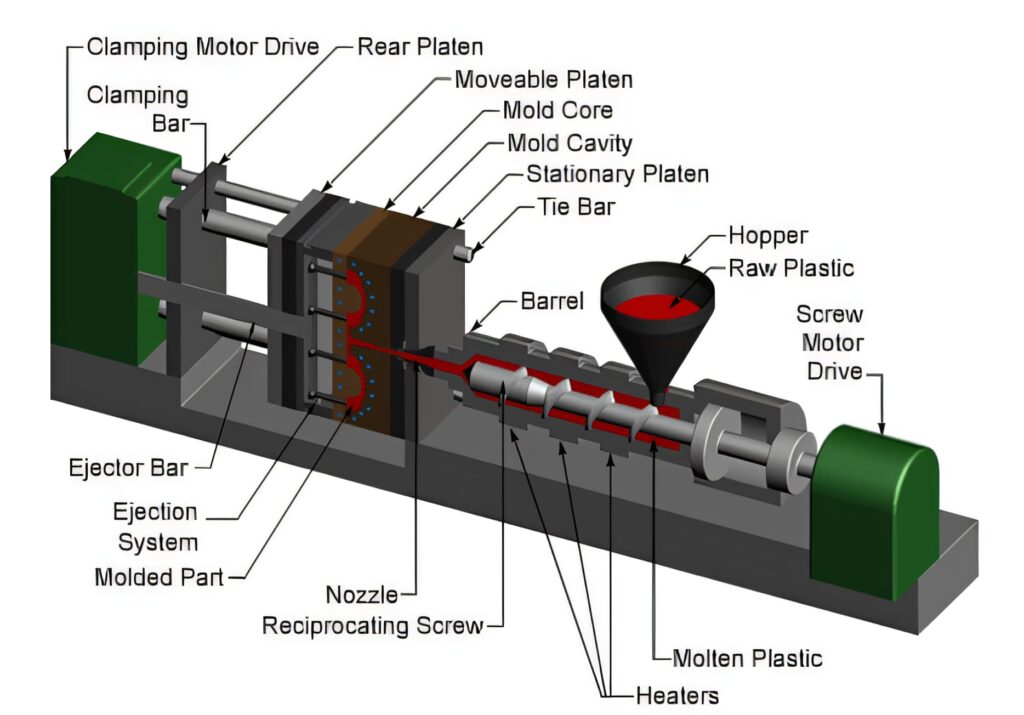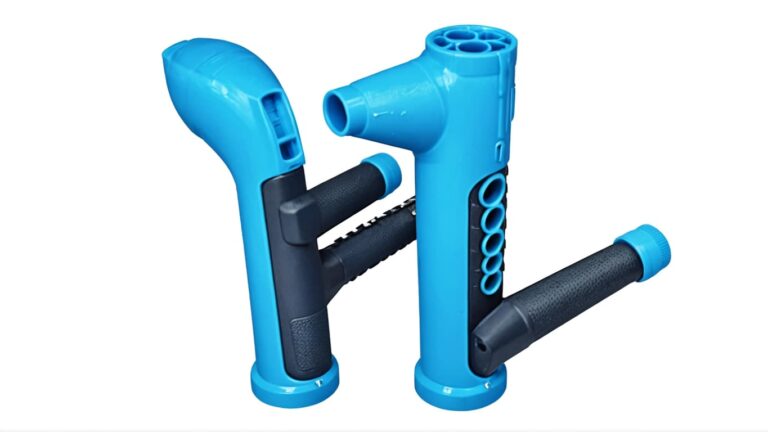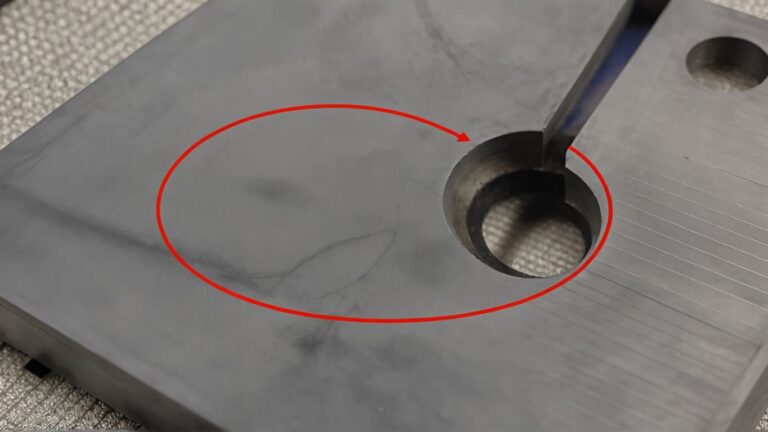Injection molding machines consist of several key components that work together to produce plastic parts efficiently. The primary components include:
- Hopper: Stores and feeds raw plastic pellets into the injection unit.
- Injection Unit: Melts the plastic and injects it into the mold cavity.
- Clamping Unit: Holds the mold tightly during injection and cooling.
Each component plays a crucial role in the overall process. The cooling unit ensures rapid solidification of plastic, while tie bars provide structural stability to the clamping unit. Proper understanding of these components is essential for optimizing machine performance.
The injection molding process follows a systematic sequence:
- Material Feeding: Plastic pellets are loaded into the hopper.
- Melting & Injection: The injection unit heats the plastic until molten and injects it into the mold.
- Clamping & Cooling: The clamping unit keeps the mold closed while the plastic cools and solidifies.
- Part Ejection: Once solidified, the mold opens, and the finished part is ejected.
Throughout the process, the injection and clamping units must work in sync to ensure precision and consistency. The role of the injection unit is to control the material flow, while the clamping unit provides necessary pressure to maintain mold integrity.
Regular maintenance is critical to keep injection molding machines operating efficiently. Key practices include:
- Routine Cleaning: Removing residue from the hopper and injection unit to prevent blockages.
- Lubrication: Ensuring moving parts, such as tie bars and clamping mechanisms, function smoothly.
- Inspection of Wear Parts: Checking seals, nozzles, and screws regularly to replace worn-out components.
Maintenance should be performed at scheduled intervals based on machine usage. A well-maintained machine reduces downtime, improves product quality, and extends equipment lifespan.
Injection molds are specialized tools used in manufacturing to shape molten plastic into precise forms. They are crucial for producing consistent, high-quality plastic parts in industries such as automotive, medical, and consumer goods. The injection molding process involves injecting molten plastic into a mold cavity, where it cools and solidifies into the desired shape. Compared to other molds like compression or blow molds, injection molds offer greater precision and efficiency, making them ideal for mass production.
Injection molds consist of several key components, each playing a vital role in the molding process. Essential parts include:
- Ejector Pins: These push the finished part out of the mold cavity after solidification.
- Sprues and Runners: Channels that guide molten plastic into the mold cavity.
- Cooling Systems: Maintain temperature control to ensure uniform cooling and prevent defects.
Each component contributes to the overall efficiency and quality of the final product. Proper mold design is critical, as inadequate cooling or poor ejector pin placement can lead to defects such as warping or incomplete fills.
Effective product design is essential for successful injection molding. Key considerations include:
- Material Selection: Choosing the right plastic affects durability, flexibility, and production cost.
- Wall Thickness Optimization: Consistent thickness prevents warping and ensures structural integrity.
- Draft Angles: Adding draft angles helps in easy ejection and reduces wear on the mold.
Common pitfalls include improper gate placement, which can lead to weak points, and inadequate venting, which may cause trapped air bubbles. By addressing these factors early in the design phase, manufacturers can improve efficiency and reduce production costs.
- Types of Spare Parts: Common spare parts include hydraulic components, electrical parts, heating elements, seals, and mechanical components like screws and barrels. Each plays a crucial role in machine functionality.
- Sources for Spare Parts: Spare parts can be obtained from OEM suppliers, third-party vendors, and specialized distributors. OEM suppliers ensure compatibility, while third-party vendors may offer cost-effective alternatives.
- Importance of Inventory Management: Maintaining a reliable spare parts inventory reduces downtime and prevents production halts. A study by Deloitte found that unplanned downtime costs industrial manufacturers an estimated $50 billion annually.
-
Step-by-Step Ordering Guide:
- Identify the required part using the machine’s manual or supplier database.
- Verify part numbers to avoid mismatches.
- Contact suppliers or use online ordering platforms.
- Confirm pricing, availability, and delivery timelines.
- Place the order and track shipment progress.
- Efficiency Tips: Establish relationships with trusted suppliers, keep a record of frequently used parts, and consider bulk purchasing for commonly replaced items.
- Understanding Lead Times: OEM parts may have longer lead times, while third-party suppliers might offer faster delivery. Planning ahead and maintaining critical components in stock minimizes operational disruptions.
-
Advantages Over Aftermarket Parts:
- Guaranteed compatibility with equipment.
- Higher reliability and durability.
- Compliance with manufacturer specifications.
- Machine Reliability and Performance: A study by the International Journal of Advanced Manufacturing Technology found that machines using non-OEM parts experience a 30% higher failure rate than those using OEM components.
- Cost Considerations: While OEM parts may have higher upfront costs, they reduce long-term maintenance expenses by preventing premature failures and ensuring optimal machine performance.
Tie-bar-less injection molding machines eliminate the conventional tie-bars found in traditional machines, offering greater flexibility in mold placement. This design allows for easier mold changes and better accessibility.
Compared to traditional machines, tie-bar-less systems provide more open space, making them suitable for larger molds that would otherwise not fit within the tie-bars’ constraints. Additionally, they improve operational efficiency by allowing for quicker setup times and reducing material waste.
These machines also save space on the factory floor, making them ideal for manufacturers with limited workspace. The absence of tie-bars enhances ergonomic benefits and simplifies maintenance, leading to cost savings in the long run.
Electric injection molding machines provide higher efficiency, precision, and repeatability compared to hydraulic systems. They utilize servo motors instead of hydraulic pumps, leading to faster response times and more accurate control over the molding process.
When compared to hydraulic machines, electric models consume significantly less energy—studies show energy savings of up to 70%, depending on the application and cycle times. This reduction in power usage translates to lower operational costs and a smaller environmental footprint.
From a sustainability perspective, electric machines eliminate the need for hydraulic oil, reducing the risk of leaks and contamination. This makes them particularly suitable for industries requiring clean production environments, such as medical device manufacturing and food packaging.
Tie-bar-less electric injection molding machines are especially beneficial in industries requiring precision and efficiency. Medical device manufacturers, automotive component producers, and electronics companies frequently use these machines due to their adaptability and precision.
Micro injection molding, which demands extreme accuracy for producing small components, benefits greatly from the tie-bar-less design, as it allows for better mold accessibility and reduced setup constraints. Additionally, these machines are well-suited for cleanroom environments, where maintaining a contaminant-free space is crucial.
In high-precision manufacturing, the absence of tie-bars reduces mechanical stress on molds, leading to longer mold lifespans and improved product consistency. This is particularly important for industries where dimensional accuracy and repeatability are critical.
- Lower Operational Costs: Electric injection molding machines (E-IMMs) reduce costs by eliminating hydraulic oil usage, minimizing maintenance expenses, and improving energy consumption efficiency. According to industry studies, E-IMMs can achieve energy savings of 30-70% compared to hydraulic machines.
- Energy Efficiency and Long-Term Savings: Electric machines operate with precision servo motors, reducing power consumption when idle. This efficiency leads to long-term savings, especially in high-volume production. Research from the Plastics Industry Association highlights that E-IMMs significantly lower electricity costs per cycle.
- Profitability-Enhancing Features: Features such as precision control systems, faster cycle times, and reduced material waste contribute to improved profitability. Many manufacturers report a 20-30% improvement in production efficiency after switching to electric machines.
- Key Selection Factors: When selecting an injection molding machine for precision parts, important factors include clamping force, shot size, repeatability, and control system accuracy. Machines with high repeatability and minimal deviation ensure consistent part quality.
- Balancing Cost and Capabilities: Decision-makers must balance initial investment costs with long-term efficiency. While electric machines have higher upfront costs than hydraulic models, their lower operational expenses and higher precision make them cost-effective over time.
- Assessing Production Needs: Evaluating production volume, material type, and part complexity helps in choosing the right machine. Manufacturers should analyze specifications such as injection speed, pressure control, and automation compatibility to match their production requirements.
- Available Service Options: Maintenance plans range from in-house preventive maintenance to manufacturer-provided service contracts. Many companies offer remote diagnostics and predictive maintenance solutions to minimize machine downtime.
- Benefits of Regular Maintenance: Regular servicing extends machine lifespan, ensures consistent product quality, and prevents unexpected failures. Studies show that unplanned downtime costs manufacturers up to $260,000 per hour, making preventive maintenance a crucial investment.
- Preventing Costly Downtime: Proactive maintenance, including routine lubrication, calibration, and part replacements, reduces the likelihood of breakdowns. Companies implementing predictive maintenance strategies have reported a 25-30% reduction in unexpected machine failures.



